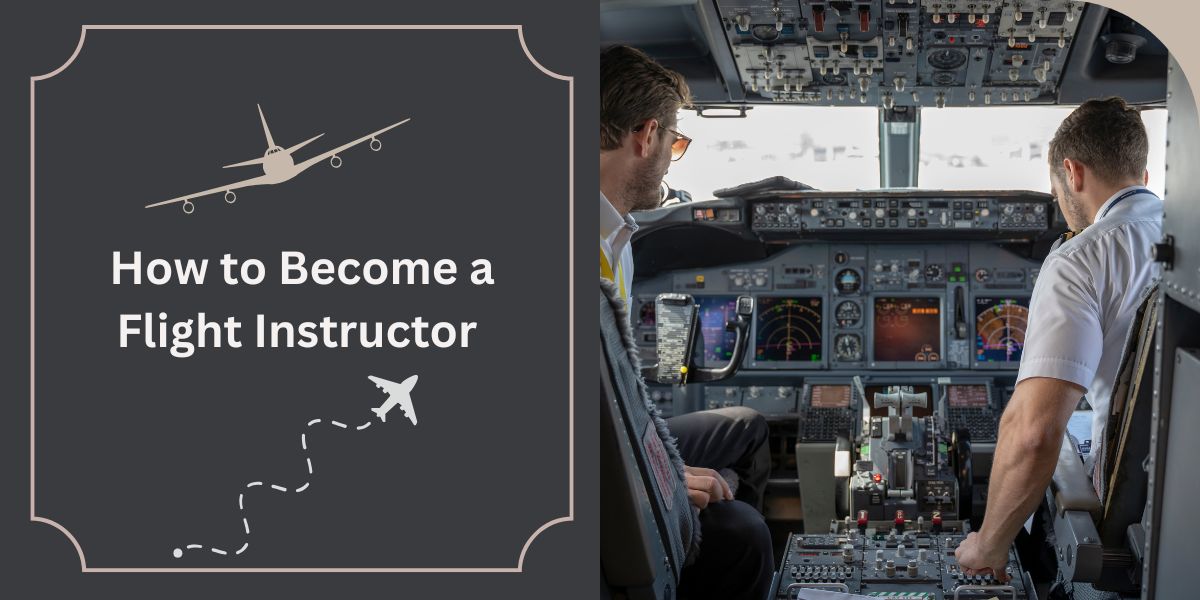If you’ve ever dreamed of taking your passion for flying to new heights, becoming a flight instructor might just be your ticket to soar. Guiding aspiring pilots through the skies is a rewarding journey that involves teaching and expertise.
So, how exactly can you turn your love for aviation into a fulfilling career as a flight instructor? Becoming a flight instructor involves a series of steps that pave the way for your aviation adventure. From mastering flight maneuvers to obtaining the necessary certifications, each stage takes you closer to your goal.
In this article, we will discuss what you need to know about flight instructors, what they do, how you can become one, and the pros and cons associated with this career.
What is a flight instructor?
A flight instructor is a trained and certified aviation educator who provides instruction and guidance to different types of pilots. Their primary role is to teach aspiring pilots the knowledge, skills, and techniques necessary to operate aircraft safely.
This involves providing both classroom instruction and in-flight training. They’re also responsible for evaluating students’ progress and assessing their readiness for flight tests and certification exams.
Additionally, a flight instructor can educate licensed pilots to help them improve their skills or earn additional certifications or ratings.
What Does a Flight Instructor Do?
Flight instructors teach aspiring pilots the basics of flying an aircraft. They ultimately help them prepare for a written test they take when applying for their pilot’s license from the Federal Aviation Administration (FAA). Review some of a flight instructor’s primary duties:
- Instructing student pilots in proper flight procedures and techniques
- Providing in-air and on-the-ground flight training
- Teaching lesson plans that involve simulators, live flight training, and textbook education
- Reporting on students’ progress and maintaining accurate records of their performance
- Developing lesson plans and new teaching methods
- Training students in various topics, including aircraft navigation, operating procedures, pre-flight and post-flight inspections, and aerodynamics
- Assisting with the development of techniques students can use to react in emergencies
How to Become a Flight Instructor
Follow these steps to become a flight instructor:
1. Meet the eligibility requirements
Before pursuing a career as a flight instructor, make sure you meet the following eligibility requirements:
- Be at least 18 years old
- Be able to understand, write, read, and speak the English language
- Hold a valid commercial pilot certificate
- Log at least 250 hours of flight time
These are preliminary requirements that you can ensure you meet before you proceed with the following steps.
2. Update your medical certificate
Before you can start your flight instructor training, you need a commercial pilot certificate. If you already have this certificate, you likely already have a current aviation medical certificate as well. Consider updating it so you can act as a pilot in command and work toward earning your certified flight instructor (CFI) credential.
The medical requirements for flight instructors depend on their desired certificate type. The requirements include vision tests, mental health assessments, and other health standards. A third-class medical certificate is the least strict, and it’s necessary for all flight operations that require an FAA medical certificate.
For example, student pilots pursuing a recreational or private certification, recreational and private pilots, and most flight instructors can benefit from having a third-class medical certificate. A first-class medical certificate is necessary for any individual who has an airline transport pilot certificate.
3. Pass the FAA and Fundamentals of Instruction (FOI) exams
Take the FAA Certified Flight Instructor Knowledge exam and the FOI exam. The FAA Knowledge exam covers various topics, including regulations, aerodynamics, weather, navigation, and aircraft systems. The FOI exam tests your aviation knowledge and instruction skills.
Upon passing these exams, you can take the FAA’s practical exam or check ride to prove your abilities to teach and fly. To help prepare for your exams, you can use study materials such as books, online courses, or test prep seminars.
4. Create lesson plans
Prepare lesson plans you intend to use as an active flight instructor. Print visual elements to aid your discussions, such as charts, diagrams, and drawings.
You can also purchase gadgets like miniature airplanes to help you explain certain topics more easily. Make sure to include the FAA Practical Test Standards (PTS) in your lesson plans.
5. Practice instructing
Undergo CFI training to practice your teaching skills. During this time, you can review PTS standards and work toward staying up-to-date with local area operations and flight acceptance reviews.
In addition, you can practice teaching your own instructor and pretend they’re your student. For example, you may demonstrate maneuvers to your instructor, watch as they demonstrate these maneuvers back to you, and provide coaching and evaluation on their performance.
On the ground, you can teach various topics and provide briefings and debriefings before and after a flight.
Practice your teaching skills until you’re comfortable teaching in different scenarios. When you’ve mastered your flight instructor role, your instructor may allow you to move on to the check ride.
6. Take the check ride
A flight instructor check ride is a practical exam that a flight instructor takes to show their ability to teach and fly. The check ride is the culmination of aviation training, where the individual proves they can lead safe and professional aircraft operations.
The test is necessary for and based on an instructor teaching students under 14 CFR Part 61 (Code of Federal Regulations).
During the check ride, an FAA safety inspector or a designated pilot examiner evaluates the candidate’s knowledge, skills, and teaching ability. Candidates can review the Flight Instructor PTS to prepare for the check ride.
Skills to Become a Flight Instructor
Consider these skills a flight instructor implements to experience success in their work:
- Technical skills: A flight instructor has a strong knowledge of aviation theory, regulations, and procedures. They’re also proficient in flying an aircraft and showing proper techniques to their students.
- Communication skills: The ability to clearly explain concepts and procedures in a way students can understand is important for this role. Good listening skills are also necessary, as instructors need to understand their students‘ concerns and questions.
- Patience: Learning to fly can be challenging, and students may make mistakes or progress at different rates. A flight instructor is patient and understanding, and they can provide constructive feedback in a supportive manner.
- Adaptability: Each student has a unique learning style, so a flight instructor can adapt their teaching methods to accommodate different learning styles and abilities.
- Safety consciousness: Flight instructors prioritize safety at all times. This means following all safety procedures and regulations and teaching students to do the same.
- Professionalism: A flight instructor implements professionalism in all elements of their work. This includes maintaining a positive attitude, being punctual and dependable, and exhibiting a solid work ethic.
- Passion for teaching: A flight instructor has a strong passion for teaching and a desire to help students succeed. Inspiring and motivating students is an integral part of being an effective instructor.
- Mathematical skills: Flight instructors have strong mathematical skills to complete their pilot training. These skills also help them plan their routes for in-flight training and keep their aircraft on course.
Flight Instructor Salary and Job Outlook
Flight instructors make a national average salary of $63,607 per year. Your salary as a flight instructor may vary depending on factors like your geographic location, employer, and skill or experience level. You may also receive benefits like relocation assistance, health insurance, and a flexible schedule.
While the U.S. Bureau of Labor Statistics (BLS) doesn’t report data for flight instructors, it has job outlook data for airline and commercial pilots. According to the BLS, airline pilots can expect employment growth of 6% from 2021 to 2031, which is a growth that’s similar to the 5% expected growth for all occupations.
What is a Certified Flight Instructor (CFI)?
A certificated flight instructor (CFI) is a pilot who has been trained by an instructor specifically on how to teach people to learn to fly. Flight instructors are responsible for taking people up in an aircraft and teaching them how to fly.
Flight Instructors must have the appropriate flight instructor certificate from the FAA and may also earn additional certification as an instrument instructor (CFII) or multiengine instructor (MEI).
Pros & Cons of Being a Certified Flight Instructor (CFI)
Becoming a CFI is a great opportunity to make money while you are learning how to fly! There are also many other benefits that you get from being a CFI, including the following:
- You can earn money flying airplanes by starting out as an instructor. Becoming a CFI can be the first step in becoming an airline pilot.
- You can fly for free. As a CFI, you get to fly for free if you are flying with paying students.
- You will get paid to learn how to fly.
- You will have the opportunity to work in an exciting and fun environment.
Some cons come with becoming a certificated flight instructor (CFI):
- It is hard work.
- You must pass both of the FAA’s written and practical exams.
- The money that you make as a CFI may not be the same as flying for a corporate flight department or the airline.
Conclusion
To be a good flight instructor, you must be an excellent pilot, have a calm demeanor, and have a passion for flying. Go back to the beginning of your flight career and learn how to break down the basics of flying an aircraft in a thorough and straightforward way.
Explain the aerodynamics of flight and describe how to manage the navigation and emergency systems, answering questions with patience. As a flight instructor, you may find yourself in tense situations, especially during a student’s first few practice flights, and you must be able to react quickly and decisively.




 Jobi.ng
Jobi.ng



